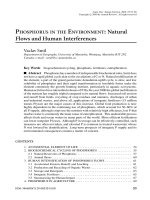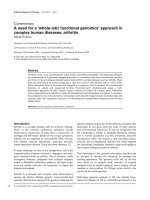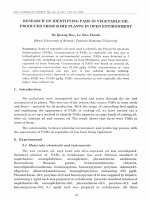taguchi approach in optimizing environment factors human
Bạn đang xem bản rút gọn của tài liệu. Xem và tải ngay bản đầy đủ của tài liệu tại đây (84.12 KB, 8 trang )
Taguchi Approach in Optimizing Environmental Factors
Human towards Productivity
A.R. Ismail
1
, M.H.M. Haniff
2
, B.M. Deros
2
, R.A. Bakar
1
1
Faculty of Mechanical Engineering, Universiti Malaysia Pahang,
26600 Pekan, Pahang, Malaysia
Phone: +609-4242268, Fax: +609-4242202
Email: ,
2
Department of Mechanical and Material Engineering,
Faculty of Engineering and Build Enviroment, Universiti Kebangsaan Malaysia,
43600 UKM Bangi, Selangor, Malaysia
ABSTRACT
Environmental factors such as lighting, temperature and relative humidity are important
factors affecting the performance of workers in the automotive industry. Therefore, the
optimal parameters must be obtained to get the best production rate. The objective of this
study is to determine the dominance effects of environmental factors such as Illuminance,
humidity and wet-bulb globe temperature (WBGT) on the workers’ performance at
Malaysian automotive industry. A case study was carried out at an automotive components
assembly factory. The environmental factors examined were the Illuminance (lux),
humidity and WBGT of the surrounding workstation area. The production rate data were
collected through observations and survey questionnaires while the illuminance level was
measured using photometer model RS 180-7133, the humidity and WBGT level were
measured by using Quest Temp apparatus and humidity. Taguchi Method was utilized to
find the sequence of dominant factors that contributed to the production rate of operator at
that specified production workstation. These results indicate that the optimum parameter
relative humidity level at level 1 (<60%), illuminance level at level 1 (<500lux) and WBGT
at level 2 (>23°C). Revenue contribution from this study will be used to improve the
performance for our country's automotive industry.
Keywords: humidity, illuminance, WBGT, taguchi method, performance
INTRODUCTION
Automotive industry is one of the dominant industries, which contributes to the Malaysian
economic growth. Therefore, healthy competition and there should be competitive in the
industry to compete in the global market. Time is a factor that is often an issue on the
productivity of an industry. Various research methods have been discovered and applied to
optimize the productivity of industry as well as high quality products. According to the
study, several factors have been identified as the cause of the decline in labor productivity.
Therefore, the parameters must be obtained for the workstation environment is not only
aimed to increase productivity and even ensure the comfort, health and safety of workers
involved (Juslen 2007).Environment and a comfortable atmosphere is an important point
because it can maintain focus and employee performance for a long time. If the focus of
their impairment, this is what led to the decline in productivity, or worse, can result in
accidents. Therefore, the values should be applied in ergonomic working environment for a
comfortable environment and quality. The utility of ergonomics research is not limited to
predicting and eliminating workplace injuries but can also be used to enhance productivity
(Resnick & Zanotti, 1997).
Relative humidity is a term used to describe the water vapor pressure of the air at given
temperature (Bridger, 1995). It is one of the environmental factors that could give an
influence towards workers’ performance. Previous research done by Gavhed & Klasson
(2005) showed that the low relative humidity resulted in more discomfort and more
frequent symptoms in facial skin and the mucous membranes such as dryness of the mouth
and throat, facial skin, more frequent symptoms of the eyes, lips and running nose.
According to the Ishii et al. (1993), Japanese people might be more sensitive to humidity
than westerners and so different methods from those used in the western countries should
be required for human thermal environmental studies with respect to the hot humid summer
in Japan. Tsutsumi et al. (2007) conducted a study to evaluate the effect of humidity on
human comfort and productivity after step changes from warm and humid environment.
The results of the study revealed that workers’ performance was found to be at the same
level under all conditions but to more tired at 70% RH after humidity step change
meanwhile more evaporation of sweat from human body at lower humidity.
Humans can attempt to maintain their internal (core) temperature within an optimum
range at around 37ºC and if the body is subjected to thermal stress the thermoregulatory
system responds by changing its state in a way which is consistent with maintaining core
temperature within this range (Parsons, 2000). Wijewardane & Jayasinghe (2008) had
conducted the study of thermal comfort temperature range for factory workers in warm
humid tropical climates. The results from this study showed that the ability to operate
factory buildings as free running will be very useful in the context of saving energy needed
from providing adequate thermal comfort for workers in warm humid tropical climatic
conditions.
A study on impact of lighting level on productivity by Juslen (2006) indicated that at
higher illumination level (1200 lux as against 800 lux) shows increase in productivity. This
study shows a change and improvement in lighting can have an effect on productivity.
Juslen (2006) also found that by increasing an illumination levels it is possible to increase a
person’s productivity. This result in line with finding by Nicol et.al (2006) who claimed
that there was a general satisfaction with the environment at higher level of illuminance.
Previous research done by Cajochen (2007) show that the human alertness increase directly
propotional with the increase of illuminance. The objective of this study was to determine
the dominance effects of environmental factors such as illuminance, humidity and WBGT
on the workers performance at Malaysian manufacturing plant.
METHODOLOGY
Selection of Location and Subjects
The study is conducted on a selected work station in the automotive industry where it refers
mainly towards the assembly section or the manual production line where human energy
are involve for in the manufacturing activity. Figure 1 shows the production line layout.
Figure 1: Handle Assembly Door Outside production line
The production is desired to be the repeated production of the same component throughout
the entire shift and this is to ensure on the consistency of the data collected towards the data
analysis later. Priority of study will be given to the work station where the environmental
factors will sponsor the most towards effect of the performance. One automotive vendor
has been selected as a place of study. A line producing a product over a period of time and
under the effects of certain relative humidity,illuminance and WBGT was chosen. Figure 2
shows the flow chart of work sequences on the production line.
Figure 2: The works sequence to assemble complete Handle Assembly Door Outside
This criterion is essential in order to obtain the which factors contribute utmost to the
worker performance based on output of assemblies among operators. The production line
was consist of 10 woman operators. The task is to assemble an automotive parts which is
known as handle assembly door outside. The standard production rate determined by the
previous feasibility study to assemble a complete handle assembly door outside was 240
units for every hour of production.
Experimental Method
The Taguchi design of experiment was employed in this experiment with two factors at two
levels each. The fractional factorial designs used was a standard L
8
orthogonal array (Park,
1996). This orthogonal array was chosen because of its minimum number of experimental
trials. Each row of the matrix represented one trial. However, the sequence in which those
trials were carried out was random. The factors and levels identified in this study were
shows in Table 1.
Table 1: Factors and levels used in the experiment
Symbol Factors Unit Level 1 Level 2
A Illuminance lux <500 >500
B Relative Humidity (%) <60 >60
C WBGT °C <23 >23
RESULTS AND DISCUSSIONS
The result of this study was based on the case study conducted on the production line in the
automotive vendor factory. The hypotheses for this study was the production rate have a
direct relationship with the illuminance, humidity and WBGT level. The levels of
illuminance, humidity and WBGT were taken to identify their effect on the worker
performances. Table 1 shows the data of production rate, illuminance, WBGT and humidity
level collected during the experimental work taken for every 30 minutes.
Table 1: Results of Average Workers’ Production Rate
Time
Level of Parameters Production
Illuminance
(lux)
Relative
Humidity,
(%)
WBGT
(˚C)
Target
(units)
Rate
(units)
09.05 – 09.35 497.65 60.76 22.98 120 119
09.35 – 10.05 505.20 59.85 23.19 120 123
10.05 – 10.35 504.65 59.21 23.13 120 121
10.35 – 11.05 503.95 59.55 23.25 120 115
11.05 – 11.35 503.83 59.29 23.15 120 121
12.05 – 12.35 501.16 59.61 22.86 120 124
12.35 – 01.05 492.45 55.98 23.25 120 108
02.10 – 02.40 489.89 55.84 23.82 120 112
The objective of the experiment is to obtain the optimize the environmental
parameters (WBGT, illuminance and humidity) in order to obtain the better results for
production rate (high value) and therefore the optimum characteristic of environment
should be quantify
Taguchi Approach
Taguchi recommends analyzing the means and S/N ratio using conceptual approach that
involves graphing the effects and visually identifying the factors that appear to be
significant, without using ANOVA, thus making the analysis simple (Park, 1996). The
bigger the better characteristic S/N ratio graph for the production rate is shown in Figure 3.
It shows that the relative humidity is the most significant factor in controlling the
production rate, followed by the illuminance and WBGT. Figure 3 also shows the optimum
condition for the production rate are at level 1 (less than 60%) of humidity, level 1 (less
than 500 Lux) of illuminance and level 2 of WBGT (more than 23°C ). The L8 orthogonal
array for environment parameters and production rate were show in Table 2
Table 2: Experimental Result for Production Rate and S/N Ratio
Experiment
Number
Level of Parameters
Production
Rate
(units)
S/N
Ratio,
(dB)
Illuminance,
(lux)
Relative
Humidity, (%)
WBGT,
(˚C)
1 <500 <60 <23 119 41.51
2 <500 <60 >23 123 41.80
3 <500 >60 <23 121 41.66
4 <500 >60 >23 115 41.21
5 >500 <60 <23 121 41.66
6 >500 <60 >23 124 41.87
7 >500 >60 <23 108 40.67
8 >500 >60 >23 112 40.98
Table 3: Response Table for Signal to Noise Ratios (Larger is Better)
Symbol Factors Mean S/N ratio (dB)
Level 1 Level 2 Rank
A Illuminance 41.54 41.29 2
B Relative Humidity 41.71 41.13 1
C WBGT 0.58 41.47 3
Table 3 shows the mean S/N ratio for each factor at two levels. From this table, the
highest value for each mean S/N ratio for each factor can be identified clearly. For the
illuminance level, the level 1 of <500 lux give the highest value, for the relative humidity









